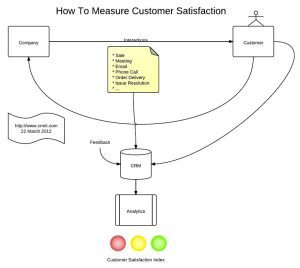Measuring Customer Satisfaction
When it comes to building business, adding new customers to the pipeline is not the only crucial aspect that should be taken into account, retaining existing customers is equally important. Customer satisfaction actually works like an interpreter for envisaging customer retention, loyalty and product repurchase. So, in an organization, a CRM system is the best way to measure customer satisfaction. CRM system can produce actionable reports for management and is also reliable enough to attach employee performance and compensation to the final results.
Here is a pictorial representation on how these things work together:
There are some critical aspects that should be taken into consideration while measuring customer satisfaction:
Quality with “Zero Defects”: Projects are never perfect and defects cannot be immediately detected at the time of delivery. But if they can be detected during the time of warranty period, customer will feel happy about the service. Though we know that a product with zero defects is rarely achieved, but customers always expect such products.
On-time delivery: For a customer nothing is more frustrating than not receiving product delivery on time. This affects “customer satisfaction”. Even if the delay is caused due to some change that customer has requested, they would still expect the product to be delivered on time.
According to an old perception, vendors always prefer to compromise with the quality rather than delaying the delivery. However, the fact is that customers might forget a delayed delivery, but they hardly ever forget poor quality and whenever asked for references, they highlight the quality factor than on-time delivery.
Price Rating: If a vendor expects his invoice to be respected fully, without any issues, then he should not bill the customer for an amount that was not agreed upon. But sometimes, contracts are drawn up as per hourly rate, thus allowing variance on both sides and whenever customer has to pay more, customer is always dissatisfied.
Issue Factor: Usually, error in the requirements or a conflict, any unclear specifications or lack of understanding the specifications causes various issues. A customer feels dissatisfied when vendors are not able to understand the requirements properly. Additionally, valid issues do not make customers dissatisfied to the extent, as trivial issues do. These really make customers annoyed.
Accommodation and Cooperation: Whenever a customer requests a change, vendors should be able to accommodate and cooperate with him, along with implementing the change without postponing the delivery of the product and without incrementing the price.
Charu Mehta
CRM Consultant, CRMIT
Tags: Article, Measuring Customer Satisfaction, Representation

